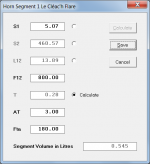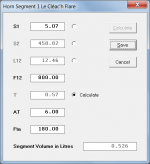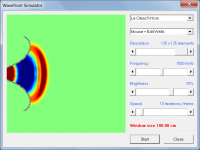I also have a Radian 475bebp which I plan to mate with a jmlc 800-horn. The Radian has an exit angle of 6 degrees. Do anyone know what would be the ideal T to match the exit angle?
When you say that the Radian has an exit angle of 6 degrees, it is not clear to me if that refers to the total included angle or just the half-angle.
Attachment 1 assumes a 3 degree half-angle (6 degree total included angle)
Attachment 2 assumes a 6 degree half-angle (12 degree total included angle)
AT is the half-angle (flare tangent angle) at the throat.
Attachments
Thank you, David! Perfect!
I have sent an email to Radian to clearify the angle-issue.
Best regards
Gisle Danielssen
I have sent an email to Radian to clearify the angle-issue.
Best regards
Gisle Danielssen
David, would you clarify something please. Is it the case that AT in hornresp for LeCleach horns refers to the tangent angle of the walls at the throat, and that geometrical matching here to the driver is appropriate, but that the LeCleach horn calls for a wavefront shape with the middle advanced of what would be the case with a spherical wavefront that is normal to the walls?
Hi AllenB,
AT (Angle at Throat) refers to the tangent angle of the walls at the throat of any Hornresp axisymmetric horn, not just the Le Cléac'h horn. In the Help file, AT is defined as the horn throat entry half-angle in degrees.
For horns with a compression driver, it is good practice to match the exit angle of the compression driver to the throat entry angle of the horn, wherever possible.
The Le Cléac'h horn wavefront is slightly "flattened" compared to a true spherical wavefront (see attachment). For both cases though, the wavefronts are normal to the horn walls and to the horn axis.
See the excellent article "Horn Theory: An Introduction, Part 2" by Bjørn Kolbrek for further information on the Le Cléac'h horn wavefront shape. The article can be downloaded from Bjørn's website page linked below.
Publications
Kind regards,
David
Is it the case that AT in hornresp for LeCleach horns refers to the tangent angle of the walls at the throat,
AT (Angle at Throat) refers to the tangent angle of the walls at the throat of any Hornresp axisymmetric horn, not just the Le Cléac'h horn. In the Help file, AT is defined as the horn throat entry half-angle in degrees.
and that geometrical matching here to the driver is appropriate,
For horns with a compression driver, it is good practice to match the exit angle of the compression driver to the throat entry angle of the horn, wherever possible.
but that the LeCleach horn calls for a wavefront shape with the middle advanced of what would be the case with a spherical wavefront that is normal to the walls?
The Le Cléac'h horn wavefront is slightly "flattened" compared to a true spherical wavefront (see attachment). For both cases though, the wavefronts are normal to the horn walls and to the horn axis.
See the excellent article "Horn Theory: An Introduction, Part 2" by Bjørn Kolbrek for further information on the Le Cléac'h horn wavefront shape. The article can be downloaded from Bjørn's website page linked below.
Publications
Kind regards,
David
Attachments
JMLC spreadsheet , where to find?
Hey Mark,
Doublecheck your figures with Jean-Michels new spreadsheet(No need, just checked it and it is the same). You will see the flare above 180 degrees though. To go beyond will give you somewhat better performance.
Good morning DIY makers, I'd like to evaluate the JMLC spreadsheet.Could you tell me where I could find it?
Best regards
Francesco
Thank you very much Mr Fudce.Here is a JMLC spreadsheet. Rename to .zip
Best regards
Francesco
- Status
- Not open for further replies.
- Home
- Loudspeakers
- Multi-Way
- My Le Cleac'h horn build


